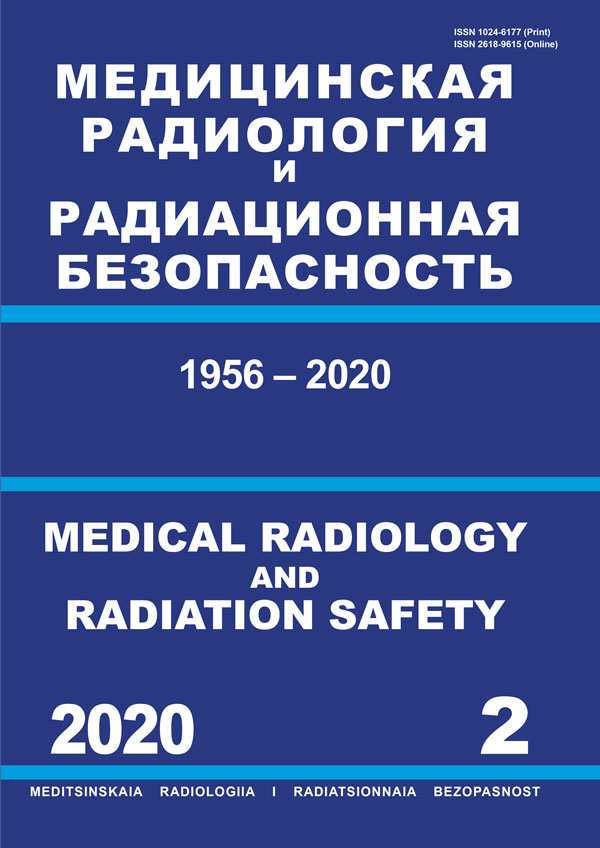CSCSTI 76.03
CSCSTI 76.33
Russian Classification of Professions by Education 14.04.02
Russian Classification of Professions by Education 31.06.2001
Russian Classification of Professions by Education 31.08.08
Russian Classification of Professions by Education 32.08.12
Russian Library and Bibliographic Classification 51
Russian Library and Bibliographic Classification 534
Russian Trade and Bibliographic Classification 5708
Russian Trade and Bibliographic Classification 5712
Russian Trade and Bibliographic Classification 5734
Russian Trade and Bibliographic Classification 6212
Neuroendocrine tumors (NETs) are a heterogeneous group of neoplasms constituting about 0.5 % of all cancer cases. In recent years, there has been a significant increase in the incidence of NETs, which is primarily due to the active development and improvement of medical imaging technologies. Successful treatment and prognosis for patients with NETs strongly depend on the stage of the disease. One of the effective methods of visualization and staging NETs in nuclear medicine is somatostin receptor scintigraphy (SRS), which is based on the use of partial somatostatin receptor agonists labeled with radioactive isotopes. The article presents an analysis of 55 patients with NETs of various localizations who underwent scintigraphy and SPECT/CT. Radiopharmaceutical was used as a tracer for SRS. It was prepared on the basis of a lyophilisate developed by Polatom (Poland) — Tektrotyd, labeled with 99mTc. According to the results of the study SRS with 99mTc-Tektrotyd is informative in the topical diagnosis of NETs, especially when PET/CT scan with 68Ga-labeled peptides is not available. Sensitivity varies depending on the NET localization. It is necessary to continue researches on the diagnostic value of SRS with 99mTc-Tektrotyd for tumors, in the pathogenesis of which somatostatin receptors play a significant role.
somatostatin-receptor scintigraphy, SPECT/CT, tektrotyd, octreoscan, neuroendocrine tumors
Введение
Нейроэндокринные опухоли (НЭО) представлены гетерогенной группой новообразований, происходящих из энтерохромаффинных клеток диффузной нейроэндокринной системы и составляющий около 0,5 % случаев от всех новообразований. Встречаются как спорадические, так и семейные варианты в рамках различных синдромов множественных эндокринных неоплазий. В последнее время отмечен рост заболеваемости НЭО. Согласно данным клинико-эпидемиологических регистров (SEER), общая частота заболеваемости составляет до 7 случаев на 100 тыс. населения в год [1, 2].
Классификация ВОЗ основана на гистологическом типе опухоли с учетом степени митотической активности и уровня экспрессии Ki-67 клетками опухоли, определяющих клинический прогноз пациента. В 2017 г. ВОЗ разделила высокодифференцированные (ВД) НЭО на 3 группы по уровню Ki67 (<3 G1; 3–20 G2; > 20 G3) и низкодифференцированные (НД) нейроэндокринные карциномы G3 (НЭК, крупно- и мелкоклеточного типа). Некоторые авторы предлагают так же подразделить группу G3 на ВД НЭО с Ki67 20–55 %; ВД НЭК 20–55 % и НД НЭК >55 %, ввиду совершенно разного прогноза заболевания и предпочтительных схем терапии в этих группах пациентов [3–5].
Часто эти опухоли могут быть выявлены случайно при выполнении рутинных диагностических исследований, так как протекают бессимптомно. Однако в ряде случаев НЭО гормонально активны и их можно заподозрить симптоматически, распознав характерную клиническую картину, вызванную гиперсекрецией определенных гормонов или биологически-активных веществ. У части пациентов, в особенности при НЭО ЖКТ, развивается карциноидный синдром, проявляющийся секреторной диареей, приливами и нередко осложняющийся кардиомиопатией.
В первую линию диагностического поиска обычно входят такие методы диагностики, как УЗИ, КТ, МРТ, эндоскопия, реже ангиография с селективным забором крови. В свою очередь, присутствие пептидных рецепторов и/или наличие механизмов поглощения нейроаминов клеточной мембраной этих опухолей позволяет использовать специфические РФЛП для диагностики и, в перспективе, терапии (принцип тераностики) [6].
1. Taal BG, Visser O. Epidemiology of neuroendocrine tumours. Neuroendocrinology. 2004;80 Suppl 1:3-7. DOI:https://doi.org/10.1159/000080731.
2. Yao JC, Hassan M, Phan A, et al. One hundred years after «carcinoid»: epidemiology of and prognostic factors for neuroendocrine tumors in 35,825 cases in the United States. J Clin Oncol. 2008;26(18):3063-72. DOI:https://doi.org/10.1200/JCO.2007.15.4377.
3. Williams E. The Classification of Carcinoid Tumours. Lancet. 1963;281(7275):238-9. DOI:https://doi.org/10.1016/s0140-6736(63)90951-6.
4. Rindi G, Arnold R, Bosman FT, et al. Nomenclature and classification of neuroendocrine neoplasms of the digestive system. In: Bosman FT, Carneiro F, Hruban RH, et al, editors. WHO classification of tumors of the digestive system. Lyon: IARC; 2010. p. S13-S14.
5. Tang LH, Basturk O, Sue JJ, Klimstra DS. A Practical Approach to the Classification of WHO Grade 3 (G3) Well-differentiated Neuroendocrine Tumor (WD-NET) and Poorly Differentiated Neuroendocrine Carcinoma (PD-NEC) of the Pancreas. Am J Surg Pathol. 2016;40(9):1192-202. DOI:https://doi.org/10.1097/PAS.0000000000000662.
6. Baranova OD, Roumiantsev PO, Slashchuk KY, Petrov LO. Radionuclide imaging and therapy in patients with neuroendocrine tumors. Endocrine Surgery. 2017;11(4):178-90. (in Russ.)
7. Kunikowska J, Lewington V, Krolicki L. Optimizing Somatostatin Receptor Imaging in Patients with Neuroendocrine Tumors: The Impact of 99mTc-HYNICTOC SPECT/SPECT/CT Versus 68Ga-DOTATATE PET/CT Upon Clinical Management. Clin Nucl Med. 2017;42(12):905-11. DOI:https://doi.org/10.1097/RLU.0000000000001877.
8. Czepczyński R, Parisella MG, Kosowicz J, Mikołajczak R, Ziemnicka K, Gryczyńska M, Signore A. Somatostatin receptor scintigraphy using 99mTc-EDDA/HYNIC-TOC in patients with medullary thyroid carcinoma. European Journal of Nuclear Medicine and Molecular Imaging, 2007;34(10):1635-45. DOI:https://doi.org/10.1007/s00259-007-0479-1.
9. Sergieva S, Robev B, Dimcheva M, Fakirova A, Hristoskova R. Clinical application of SPECT-CT with 99mTc-Tektrotyd in bronchial and thymic neuroendocrine tumors (NETs). Nuclear Medicine Review. 2016;19(2):81-7. DOI:https://doi.org/10.5603/NMR.2016.0017.
10. Artiko V, Afgan A, Petrovič J, Radovič B, Petrovič N, Vlajković M, Obradović V. Evaluation of neuroendocrine tumors with 99mTc-EDDA/HYNIC TOC. Nuclear Medicine Review. 2016;19(2):99-103. DOI:https://doi.org/10.5603/NMR.2016.0020.
11. Garai I, Barna S, Nagy G, & Forgács A. Limitations and pitfalls of 99mTc-EDDA/ /HYNIC-TOC (Tektrotyd) scintigraphy. Nuclear Medicine Review. 2016;19(2):93-8. DOI:https://doi.org/10.5603/NMR.2016.0019.
12. Al-Chalabi H, Cook A, Ellis C, Patel CN, Scarsbrook AF. Feasibility of a streamlined imaging protocol in technetium-99m-Tektrotyd somatostatin receptor SPECT/CT. Clinical Radiology. 2018;73(6):527-34. DOI:https://doi.org/10.1016/j.crad.2017.12.019.
13. Briganti V, Cuccurullo V, Di Stasio GD, Mansi, L. (2019). Gamma emitters in pancreatic endocrine tumors imaging in the PET era: is there a clinical space for 99mTc-peptides? Current Radiopharmaceuticals. DOI:https://doi.org/10.2174/1874471012666190301122524.
14. Boutsikou E, Porpodis K, Chatzipavlidou V, Hardavella G, Gerasimou G, Domvri K, Zarogoulidis K. Predictive Value of 99mTC-hynic-toc Scintigraphy in Lung Neuroendocrine Tumor Diagnosis. Technology in Cancer Research & Treatment, 2019;18:1-18. DOI:https://doi.org/10.1177/1533033819842586.





